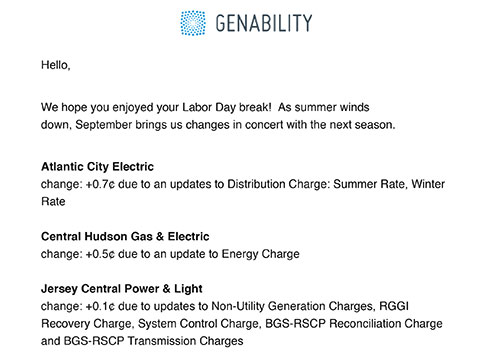Tariff News
The Methodology Behind our Monthly Residential Rates Newsletter
By Trevor Kennard
| Reading time 2 minutes
Every month Genability updates thousands of tariffs. These changes can be as small as a simple rate increase or as large as a whole new rate structure. For just over a year now, around the 10th of each month, we have sent out a summary of those changes in our Monthly Residential Rate newsletter to help our customers better understand and anticipate these changes.

The feedback has been overwhelmingly positive so we thought we would share a bit about all the background number crunching and data checks that go into those updates.
Tracking Avoided Cost of Power (ACP)
Every month our Data & Operations team processes thousands of rate changes, about 2,000 tariffs per month. While the volume of changes can be dizzying, we need a way to ensure the rate changes are free from errors. One way of doing so is to use a tool that’s available to our Switch customers: Savings Analysis. Along with internal data quality checks, we utilize Savings Analysis as a proxy for data quality by tracking ACP changes for the top utilities across the country. From there, we execute a twelve month calculation via Genability’s Calculate API to see which individual rates changed. Lastly, we check that the individual rate changes were entered properly and make necessary corrections. Not all changes will result in significant changes to ACP so we highlight changes that incur at least a 0.1¢ change to a typical customer’s ACP.
How do we use Savings Analyses?
We set up prototype test accounts within the service territory of major utilities across the United States with a standard consumption profile and solar profile that represents a typical customer (usage of 8400 or 9400 kWh per year, and a 4 kW system). Each morning we execute a Savings Analysis against all these accounts using the default residential tariff of the utility. For example, for Consolidated Edison we use EL1, for Pacific Gas and Electric we use E-1. Then we use an internal engine that looks for any differences between the current Savings Analysis response and the day before. We review any differences returned by the engine against tariff documentation to ensure the changes are correct. If there are any discrepancies we quickly correct them and then execute another run of Savings Analyses.
NEM 2.0 and Beyond
Since we started sending out these monthly updates this method has evolved over time. In the ever changing landscape of net metering, the introduction of NEM 2.0 and forced tariff switch, we’ve taken advantage of our solarPvEligible logic to track ACP when a customer must select a new tariff after going solar. This gives our customers who subscribe to the Monthly Residential Rate Update a real-world view into what caused the ACP change and how tariff switching affects ACP. Where utilities enforce a tariff switch, our solarPvEligible logic will pick the most likely tariff after going solar. For customers of utilities that do not require a tariff switch when going solar, the post solar tariff is the same as the pre solar tariff.
If your organization would benefit from the great information in the Monthly Residential Rate Newsletter you can sign up for it here.
Also in Tariff News
Net Energy Metering Rules Change Across the US, We have it Covered.
By John Tucker | Aug 23, 2017
Nevada Energy Net Metering Tariffs Explained
By John Tucker | Jun 19, 2017
Florida Electricity Rates in to our Utility Rate Database
By Charity Vargas | Dec 20, 2016
Investigating the Effect of California’s NEM 2.0 on Solar Savings
By Kevin Timms | Mar 8, 2016

